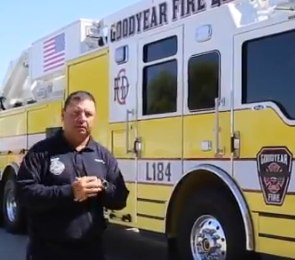In November 2019, 1-800-BOARDUP posted the below article on our Facebook page and it inspired a multitude of comments and discussion. We’re including it in this issue of the Maltese Cross in hopes of inspiring discussion in your department and communities about the pros and cons of this new design.

FireRescue1: A new fire truck designed to shield firefighters from carcinogens was unveiled at the Goodyear Fire Department last week.
The clean cab design includes compartments with roll-up doors on the side of the apparatus to store gear after responding to a scene, while the cab has no hooks or areas for the crew to place gear, Fire Capt. Jose Aguirre explained in a video released by the department.
In this screenshot from a video published by the city of Goodyear and the Goodyear Fire Department, Fire Capt. Jose Aguirre explains the components of the department’s new clean cab fire truck designed to reduce cancer risks. (Photo/Goodyear, AZ Twitter)
“What that means is no more gear, no more turnouts, no more SCBAs will be allowed in the cab,” Aguirre said. “So, a very wipeable, cleanable cab on the inside.”
The clean cab initiative is part of the department’s cancer prevention program, Aguirre said. The goal of the design is to minimize contamination of the crew compartment by potentially-cancer-causing products of combustion.
In 2015, Goodyear Firefighter Gilbert Aguirre was diagnosed with leukemia, which he believed to be directly caused by his job, according to KTAR News. Earlier this year, Goodyear Firefighter Austin Peck passed away from a rare form of sinus cancer, also believed to have resulted from his job.
The department hopes to be a pioneer for clean cab initiatives being implemented across the country. The city says it is one of the first to adopt the program.
“A fire truck with no ability to hang your turnouts and your SCBAs in the cab – that’s a paradigm shift,” said Capt. Aguirre.
Some commentary has been included below for discussion (directly excerpted):
FireEngineering.com (P.J. Norwood): The clean cab concept is one piece of the puzzle when it comes to cancer reduction in the fire service, though it’s not a complete solution. We need to continue forward momentum in the advancement of our profession. We must make sure such cancer-mitigating efforts do not have a negative impact on our ability to do the job we are entrusted to by the citizens of our community. We must balance decreasing our exposure to unnecessary risks with operational readiness. Operational readiness should not be minimized to reduce our risk of exposure to carcinogens.
RigSpot (Bill Adams) :
Operational Concerns
There is no attempt to disparage or lessen the attempt to eliminate carcinogens in a cab or negate the quest for an environmentally safe cab. There are, however, possible ramifications purchasers should be aware of. As mentioned, there is the possibility of losing seating capacity and increasing a rig’s overall length, wheelbase, and turning radius. Storage space must be found for equipment formerly carried in the crew cab and external cab compartments. There may be the possibility of external compartments extending into the cab area reducing the visibility looking outside the cab.
A pedestal pump may not always be suitable for every fireground pump operation. Shrunken pump panels may reduce access for pump service and the location of controls and hose connections. Departments that keep their clean gear outside the cab should consider how long it will take for firefighters to exit a cab and don full protective clothing after arrival. Consider doing so in inclement weather.
Another item that should be addressed is after a situation when contaminated gear is “boxed, bagged, and tagged” and secured outside the cab. What is the procedure if another alarm comes in when the rig is on its way back to quarters? Is the rig out of service until it returns to quarters and secures clean gear? And, who makes the determination as to the amount of or duration of exposure to possible carcinogens before gear is bagged-and-tagged? Although these possibilities may be irrelevant when dealing with firefighter safety, they should be evaluated and procedures established before rather than after the fact.
Emotional Concerns
Accepting the premise of an environmentally safe cab may be hard for fire service traditionalists to accept. The complaining will be similar to the wailing when firefighters were pulled off the rear step, forced to wear protective hoods, not wear ¾-length boots, and when roofs and doors were required on fire trucks. Precondition the known vocal and outspoken members.
You might have to address the public who are not used to watching six firefighters getting geared up after getting off the fire truck. They might relate it to arriving on time to pick up your date and finding out he or she is still in the shower. Beware of firefighters who may not fully gear up because of a potentially dangerous situation seen upon arrival. Firefighter safety is paramount, and training is the key.
